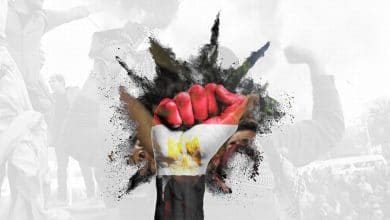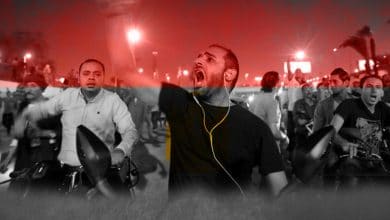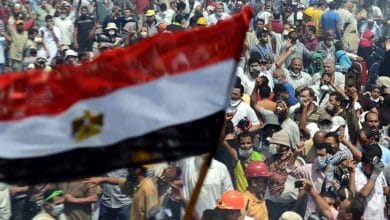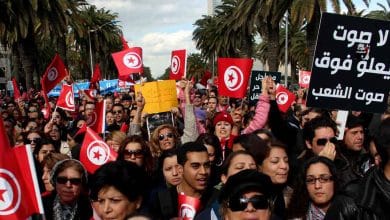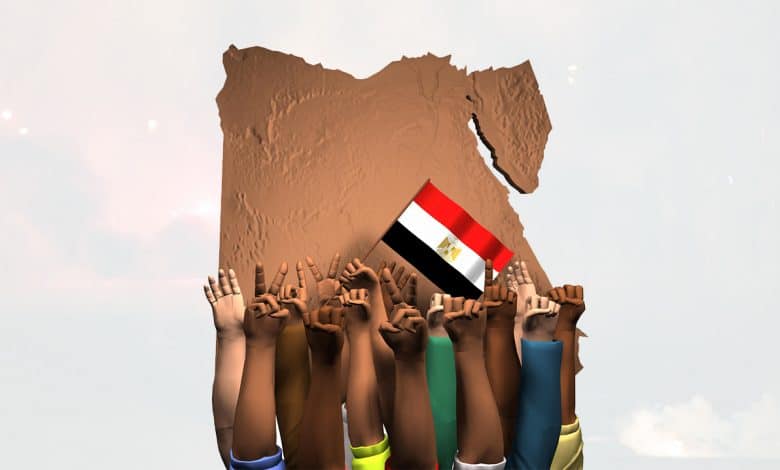
The public opinion, both at home and abroad, has recently been preoccupied with the Egyptian issue after a whole week of the demonstrations that erupted in several Egyptian governorates and villages, demanding the departure of Sisi and his regime, due to the deterioration of living conditions resulting from many political and economic crises, especially after the government’s move to raze people’s homes under the pretext of being built without a building permit or constructed on agricultural land, mostly the homes of the low-income people in rural areas and in urban slums surrounding large cities.
In light of the regime’s fear of the consequences of these protests, the Egyptian security services have attempted to preempt the events by launching a widespread arrest campaign that included prominent political figures and a number of activists, especially in the city of Suez. On the other hand the pro-regime media launched a sharp attack on the calls for demonstrations, considering them part of a foreign plot aimed at bringing down the Egyptian State.
But in coincidence with the attacks launched against the protests and the attempts to distort protesters, the demonstrators received strong support, both internally and externally, which motivated more people to take to the streets and participate in these demonstrations over a whole week, calling for Sisi to step down.
Internal support
The Revolutionary Socialists movement announced in a statement its solidarity with the protests of the low-income people from the countryside and some neighborhoods surrounding cities, stressing that it supports every mass protest against the policies of impoverishment and persecution practiced by the authorities, and that the masses have the absolute right to protest and express themselves. The leftist movement also affirmed rejection of the policies of security-related prosecutions, repression and arrests practiced against demonstrators, demanding the release of all detainees and holding those responsible for suppression of demonstrations accountable.
After a long silence, the Dostour (constitution) Party announced in a statement its support for the recent demonstrations, stating that “Egypt has witnessed in the past few days protests in villages and suburbs of many governorates, both in Upper Egypt and Lower Egypt, to demonstrate the intense congestion and wrath of a large sector of the Egyptian people, and that “the people are fed up with the policies and decisions that weighed on its shoulders. At the time when the Egyptian citizen barely woke up from the economic impact of the coronavirus pandemic, he found himself required to bear the responsibility of the mistakes of previous governments that had been lax in facing the corruption of localities for many years…”
External support
Egyptian opposition in exile have also organized a series of protest activities to express their support and solidarity with the protest movement at home, demanding the departure of Sisi. Coalitions and gatherings of Egyptians abroad have announced organization of 13 events, ranging from a protest stand to a demonstration in support of the revolutionary movement in Egypt since the beginning of the September protests.
Some vigils were held in the French capital, Paris, as well as the city of Milan in Italy, Amsterdam in the Netherlands, Sydney in Australia, the city of Munich in Germany, and Sarajevo in Bosnia.
Scene analysis
There are several striking scenes in the recent protests of simple Egyptians who have demonstrated while wearing the traditional Egyptian costume, the galabiya, which has important indications about the motives of demonstrators that took to the streets demanding the departure of Sisi, most prominently:
Obvious Humiliation
In some of the scenes of demonstrations, the protesters were seen tearing down the pictures of Sisi, running over them with feet, and even setting them on fire in some places, especially in Upper Egypt. Such scenes remind Egyptians of some of the old scenes that occurred in the Mahalla governorate in 2008 during the era of the late President Hosni Mubarak, when demonstrators at the time tore down pictures of Mubarak, which confirms that enough is enough for the Egyptians, and proves that they can no longer bear the suffering imposed on them. If Sisi maintains these policies followed since the July 2013 coup, his end will be inevitable, as was the end of Mubarak.
Significance of children’s participation
Many children joined the recent protests, chanted against Sisi, and even participated in setting his pictures on fire and stomping on them. This scene is a new, remarkable and significant development, which indicates that he future generations, who have experienced the woes and distress from their early childhood, have overlooked the security forces deployed everywhere and insisted on participating in demonstrations despite their young age.
Egyptian security forces have killed 3 of the so-called ‘galabiya demonstrators’, namely: Sami Wagdy Sayed Bashir (25), Reda Mohamed Hamed (22), and Mohamed Nasser Hamdi Ismail (13). However, the Egyptian Public Prosecutor ordered the release of 68 children who had been arrested by Egyptian authorities for participation in the protests, which illustrates the age group that is aware of the danger of Sisi’s remaining in power.
Continued protests
The popular movement has continued for a week and even more, despite the continued arrest campaigns and the great security alert in the main squares, as more than 50 villages and cities in a number of Egyptian governorates were monitored as participating in the protest vigils and marches, which confirms that the protests have popular demands, and they are likely to re-emerge in the coming periods.
Popular response to Sisi’s referendum proposal
The popular protests or the ‘galabiya’ protests, as some observers call them, came one month after Sisi announced the possibility of holding a referendum on his staying in power in the event that the Egyptian people were not satisfied with the measures he took. Therefore, the response came from the simple Egyptian people in the form of protests demanding his departure.
Role of Egyptian media
The media has no longer anything new to show except for the repeated staging of artificial scenes in support of Sisi that the public have become so familiar with. For more than seven years, the regime has been repeating the same scenes without any attempt to renovate to convince the people or convince the world.
No occasion has passed without Sisi’s warning of Egyptian opposition channels abroad, describing them as “offensive channels that destroy and sabotage peoples”, which confirms the importance of the role played by the revolutionary media in exile, especially in covering the protests.
In turn, the pro- Egyptian regime media could not overlook the protests demanding the departure of Sisi and the fall of the regime, as they imposed themselves on the scene. Accordingly, the pro-regime media messages in Egypt carried the same content, which confirms their commitment to the messages sent to them by the security services, most prominently admitting that there are protests, but confirming that they are very limited.
The talk show programs in the pro-regime TV satellite channels ignored the video clips of the popular protests that demanded Sisi to step down, and only focused on accusing opposition TV channels abroad of exaggerating the events, claiming that there are protests everywhere in the world, such as in France and other countries, in an open attempt by the pro-Egyptian regime media to downplay matters and calm the Egyptian street, similarly to the same role that the Egyptian media played during the January 25 revolution against the Mubarak era.
Support rallies upon the ruler’s orders
In attempt to cover up the scenes of demonstrations and protests calling for the fall of the regime, the ONTV channel, affiliated to the Egyptians Media Group owned by the Egyptian General Intelligence Service (GIS), broadcasted car rallies organized in support of Sisi, under the protection of security forces, while traffic officers were organizing the procession.
Attempts to calm down
There have been several attempts to calm the situation down during the protests, which lasted for more than a week, where Al-Sisi ordered the government to continue offering a grant of EGP500 to irregular workers for another 3 months, until the end of this year. This step was preceded by issuance of some decisions by Prime Minister Mostafa Madbouly to reduce the amounts of money required of citizens to avoid demolition of their homes, claiming that they violate the building requirements, as well as giving violators an additional month to reconcile with authorities and pay the required fines to avoid demolition of their homes.
The Nation’s Future Party, which is loyal to the ruling regime in Egypt, also announced that it would bear the costs of reconciliation in construction violations for all the incapable families in Luxor Governorate.
At the same time, the “Decent Life” initiative, launched by Abdel Fattah al-Sisi on January 2, 2019, announced allocation of EGP150 million, required for the reconciliation in building violations in the following governorates: Assiut, Sohag, El-Menya, Qena, Luxor, New Valley, Marsa Matrouh, and Beheira, which raises doubts about the seriousness of the move.
Also in order to ensure the army’s loyalty, Abdel Fattah al-Sisi granted the Egyptian army the right to exploit quarries for 30 years, which contradicts Article 32 of the Egyptian Constitution which states that: “Natural resources belong to the people. The state commits to preserving such resources, to their sound exploitation, to preventing their depletion, and to take into consideration the rights of future generations to them.”
Sisi justifies and threatens
In his first statements in the wake of the September demonstrations, Sisi spoke about the country’s economic conditions and the razing of buildings that was one of the main reasons for Egyptians to take to the streets. However, he relied in his speech on two main prospects, namely justification and threatening: he justified the decisions to demolish buildings by saying that “any razing of buildings is made for the public benefit and not at the expense of the people,” claiming that the government provides temporary housing for people whose homes are razed, which did not happen, according to observers. Sisi also warned that failure to make difficult decisions would make the country go through more difficult circumstances. Al-Sisi did not forget to hold the January 25, 2011 revolution responsible for suspension of the development projects in Egypt, saying, “There are projects that have been suspended due to the events of 2011 and the state of instability.”
Egyptian people’s message
The map of the recent Egyptian demonstrations has important implications for measuring the farmers’ level of wrath against the Sisi regime. The Egyptian countryside, which is the largest area in Egypt, is the most affected by the practices of the Sisi regime. The participation of the Egyptian countryside in protests in this way heralds a great popular burst if the regime maintains the same practices that have inflicted losses on farmers that cannot be sustained any more.
The galabiya-protests in Egypt confirm that demonstrations are still possible, even in the absence of media, parties, unions, or any political or popular organization. The popular protests over the course of a week also confirms that the non-ideologized low-income and working-class Egyptians are aware of their demands and rights, and fully aware of the seriousness of the crisis that the country is going through as a result of the policies of Sisi and his regime. Through these demonstrations, the Egyptian people are sending a message to Sisi and to the whole world that they are still existing, taking into account that it has been proven throughout the history that regimes disappear but people remain.
